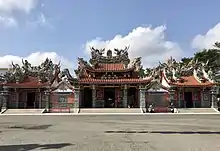Bengang Tianhou Temple
Bengang Tianhou Temple (Chinese: 笨港天后宮; pinyin: Bèngǎng Tiānhòu Gōng) is a temple located in Nangang Village, Xingang Township, Chiayi County, Taiwan. Sitting on the south shore of the Beigang River, the temple is dedicated to Mazu, a sea goddess.
| Tianhou Temple | |
|---|---|
天后宮 | |
 | |
| Religion | |
| Affiliation | Taoism |
| Deity | Mazu |
| Location | |
| Location | Xingang, Chiayi |
| Country | Taiwan |
| Geographic coordinates | 23.5616°N 120.3081°E |
| Architecture | |
| Groundbreaking | 1998 |
| Completed | 2002 |
| Direction of façade | East |
History
In 1713, a Mazu temple named Tianhou Temple was built in Bengang (current day Beigang, Yunlin and Nangang Village) east of the current location. Sometime later, a potter named Yang Qian (楊謙) moved from Bengang to Changhua in search of work. According to legend, the incense bag that he carried with him for protection began glowing, which the people of Changhua believed to be Mazu showing herself. Therefore, Changhua's Nanyao Temple was built in 1738 honoring Mazu.[1]
Some time afterwards, Yang Qian moved back to Bengang near Shuixian Temple. In 1815, Nanyao Temple began the tradition of making a pilgrimage to the Yang residence to pay tribute to their origins. Yang Qian's descendants thought that a deity visiting a mortal was strange, so they asked Nanyao Temple to sculpt a Mazu statue for them, which they stored in Tianhou Temple. Later, the Yang family fell into financial trouble, so during the pilgrimage, Nanyao Temple would replace the clothes on the statue.[2][3]
The 1906 Meishan earthquake destroyed Tianhou Temple, so the statue was moved to the Yang residence, where the tradition continued.[1] Towards the end of World War II, the men in the Yang family were drafted by the Imperial Japanese Army and all died in combat. Since no one could take care of the Mazu statue, the statue was moved to Shuixian Temple where the ceremonies continued.[4]
In 1998, worshippers bought a tract of land directly adjacent to Shuixian Temple to rebuild Tianhou Temple. The new temple measured 420 ping and took five years to complete.[1] The temple was built using traditional methods: notably, the carpenter was the son of the carpenter that helped renovate Shuixian Temple.[5] On 10 October 2002, a ceremony was held to move the Mazu statue from Shuixian Temple, and future pilgrimages from Nanyao Temple ended at the new Tianhou Temple.[1][4]
See also
References
| Wikimedia Commons has media related to Benggang Tianhou Temple. |
- "笨港天后宮". Cultural Resources Geographical Information System (in Chinese). Academia Sinica. Retrieved 21 November 2020.
- 吳敏菁 (26 March 2015). "南瑤宮笨港進香 換龍袍傳遞神明姊妹情" (in Chinese). China Times. Retrieved 21 November 2020.
- 王善嬿 (27 March 2019). "彰化南瑤宮抵笨港天后宮 「開臺祖家媽」換龍袍男性迴避" (in Chinese). Liberty Times. Retrieved 21 November 2020.
- 鄧富珍 (27 March 2018). "彰化南瑤宮笨港進香重頭戲 「換龍袍」儀式登場" (in Chinese). 台灣好新聞. Retrieved 21 November 2020.
- 黃淑莉 (28 October 2019). "完全不用釘子 劉鴻林「大木作」獲登技術保存者" (in Chinese). Liberty Times. Retrieved 21 November 2020.